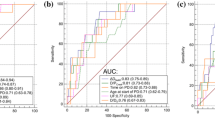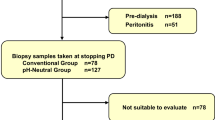Abstract
Background. We investigated peritoneal protein selectivity to evaluate whether it may indicate changes in peritoneal pores and be related to the morphological changes in the peritoneal membrane during the course of continuous ambulatory peritoneal dialysis (CAPD) therapy.
Methods. Seventeen patients on CAPD (11 men, 6 women; average age, 48.4 ± 2.8 years [mean ± SE]) were studied. The duration of CAPD ranged from 1 to 42 months (21.7 ± 3.8 months [mean ± SE]). Urea nitrogen, creatinine, transferrin, and IgG in both serum and CAPD waste fluid were measured, and dialysate/plasma (D/P) ratios for these substances were determined. To evaluate changes in the large pores, in the peritoneal membrane, the peritoneal selectivity index (PSI) was calculated in the same manner as the urinary protein selectivity index is determined; namely, as the ratio of IgG clearance to transferrin clearance into CAPD waste fluid.
Results. There was no significant correlation among the D/P ratios for urea nitrogen, creatinine, transferrin, IgG, and the duration of CAPD therapy. However, the PSI showed low-grade selectivity in patients on relatively shorter periods of CAPD therapy, and high-grade selectivity in patients with longer periods of CAPD therapy. There was a significant inverse correlation between the PSI (Y) and the duration of CAPD therapy (X) (Y = −0.007X + 0.75; r = 0.75, P < 0.05). We performed a prospective study after 12 months, and 8 patients were available to measure PSI again, and almost all patients showed a decrease in the PSI (−22.8 ± 0.8%; P < 0.02). In addition, we carried out morphological evaluation of the peritoneum in 13 patients who stopped CAPD. There was a significant difference in PSI value between those with and without peritoneal fibrotic change, while there was no significant difference in PSI values for those with and without mesothelial damage or with and without arteriolar sclerosis.
Conclusions. From these results, we hypothesize that reduction in the PSI may reflect the shrinkage of large peritoneal pores and the presence of peritoneal fibrotic change in CAPD patients.
Similar content being viewed by others
Author information
Authors and Affiliations
Additional information
Received: January 9, 2001 / Accepted: July 30, 2001
About this article
Cite this article
Saito, O., Kusano, E., Homma, S. et al. Reduced peritoneal protein selectivity may indicate peritoneal fibrosis in CAPD patients. Clin Exp Nephrol 5, 222–227 (2001). https://doi.org/10.1007/s10157-001-8017-0
Issue Date:
DOI: https://doi.org/10.1007/s10157-001-8017-0




